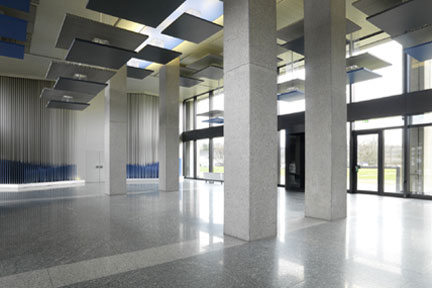Jesús Rafael Soto, Installation in the Entrance Hall in the Central Office, 1972

Mondrian’s later works – The Victory Boogie Woogie – those lights! That is where we see vibration being incorporated into painting for the first time. It seemed to me […] that he was on the verge of bringing a visual motion into the picture
, wrote the Venezuelan artist Jesús Rafael Soto, who lived and worked in Paris. The avant-garde of the early twentieth century had combined an interest in formalist construction with the ‘moment of motion’. This inspired the Op art movement of the 1960s, which came into being in 1955 with the groundbreaking exhibition "Le Mouvement" in the Parisian Denise René Gallery – the first to bring together the growing number of pieces that explored ways of incorporating movement into artworks. As Pontus Hultén wrote in the accompanying brochure, the aim was to reflect the major discovery of the twentieth century – time, the fourth dimension.
The material of Soto’s three-dimensional artworks often already contains this ‘moment of motion’. The dense meshing in the ‘vibration structures’ appears to evaporate as the viewer walks away from the work, only to re-form in new constellations. In his often expansive installations, such as that in the entrance hall of the Bundesbank’s central office in Frankfurt, viewers can always observe this dual motion simply by looking at the work from a different position or angle. This is art designed as a criticism of perception and awareness.